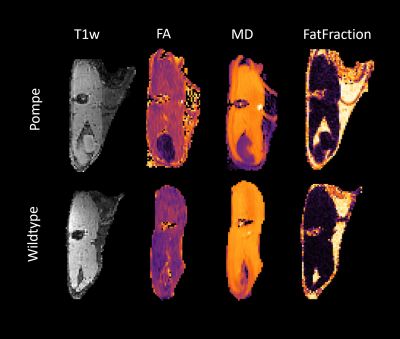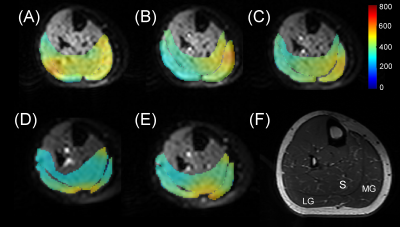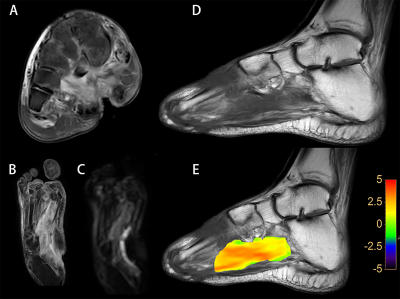Traditional Poster
Musculoskeletal
ISMRM & ISMRT Annual Meeting & Exhibition • 03-08 June 2023 • Toronto, ON, Canada

| Booth # | |||
|---|---|---|---|
5366. |
Autophagic accumulations are related to diffusion parameters in
non-fat infiltrated muscles of the Pompe mouse
Marlena Rohm1,2,
Gabriele Russo3,4,
Xavier Helluy3,5,
Martijn Froeling6,
Denise Manahan-Vaughan3,
Matthias Vorgerd1,2,
and Lara Schlaffke1
1Department of Neurology, BG-University Hospital Bergmannsheil gGmbH, Bochum, Germany, 2BG-University Hospital Bergmannsheil gGmbH, Heimer Institute for Muscle Research, Bochum, Germany, 3Department of Neurophysiology, Ruhr-University Bochum, Bochum, Germany, 4International Graduate School of Neuroscience, Ruhr-University Bochum, Bochum, Germany, 5Department of Biopsychology, Institute of Cognitive Neuroscience, Faculty of Psychology, Ruhr-University Bochum, Bochum, Germany, 6Department of Radiology, University Medical Centre Utrecht, Utrecht, Netherlands Keywords: Muscle, Translational Studies, Longitudinal Studies In Pompe disease a mutation in the alpha-glucosidase gene leads to accumulation of glycogen and autophagosomes. Previously, we reported changes in diffusion in patient muscles. To identify histopathological correlations, the quantitative MRI protocol was translated to a mouse model, using DTI sequences in a monthly interval to scan the hind limb of pre-symptomatic mice. Subsequently, immunofluorescence stainings and glycogen assay were carried out to correlate glycogen accumulation and autophagic buildup with diffusion changes. No fat-infiltration was detected, while FA increases significantly compared to wildtype. Changes in diffusion parameters were correlated to autophagic buildup but did not correlate with glycogen accumulations. |
||
5367. |
Perturbation of calf-muscle stiffness with graded plantar
flexions as measured by magnetic resonance elastography
Jialin Wang1,
Xin Mu2,
Mingyan Wu1,
Yanbin Li1,
Huahui Xu3,4,
Xiaoli Gu3,4,
and Jeff L. Zhang2
1Central Research Institute, United Imaging Healthcare, Shanghai, China, 2School of Biomedical Engineering, ShanghaiTech University, Shanghai, China, 3Institute of Arthritis Research in Integrative Medicine, Shanghai Academy of Traditional Chinese Medicine, Shanghai, China, 4Department of Radiology, Shanghai Guanghua Hospital of Integrative Medicine, Shanghai, China Keywords: Skeletal, Elastography Using magnetic resonance elastography (MRE), we investigated the potential changes in the stiffness of calf muscle with plantar flexion. Significant decreases in shear modulus were found when exercise was applied in a progressive way. Such decrease was possibly due to the increase muscle hyperemia in exercise, which was partially verified by increased T2-weighted signals in the same study. In conclusion, MRE is a promising method for measuring mechanical viscoelastic properties of skeletal muscles and thus for assessing muscle function or performance. |
||
5368. |
Elevated blood flow and amide proton transfer weighted signal in
diabetic foot: a novel clinical research using non-contrast
imaging
Shan Lu1,
Shiyu Zhao1,
Xueyan Song1,
Guangyang Ma1,
Zhiwei Shen2,
and Baocheng Chang*1
1Metabolic Diseases Hospital of Tianjin Medical University, Tianjin, China, 2Philips Healthcare, Beijing, China Keywords: Muscle, Infection For the first time, DF infection was analyzed using ASL and APTw imaging, and high BF and MTRasym (3.5 ppm) may be used as a novel biomarker in DF course monitoring and treatment option evaluation. ASL and APTw imaging in DF may be a safe and convenient approach for individuals with renal insufficiency because to its non-contrast injection. |
||
The International Society for Magnetic Resonance in Medicine is accredited by the Accreditation Council for Continuing Medical Education to provide continuing medical education for physicians.